We get a high yield with minimal costs and risks by growing the “Collective Farm Harvest” tomato
The main advantage of the Kolkhoz Harvest tomato is reflected in the name. The culture has been known for a long time, since Soviet times, and for decades remains a favorite among most gardeners.
Ripe vegetables are valued for their high content of microelements and vitamins, and caring for the plant is so simple that any novice gardener can handle it. The variety is a product of domestic selection and is ready to please even residents of the northern regions with a high level of fruiting.
Description of the variety
The Kolkhoz productive tomato variety is intended for cultivation in open ground. But this does not mean at all that it will not be accepted in greenhouse conditions. According to numerous reviews, the maximum amount of harvest is obtained in closed structures.
Reference! Many gardeners confuse two types: Collective Farm Harvest and Collective Farm Queen. In terms of characteristics, photos and reviews, the Kolkhoz Queen is very different from the Kolkhoz Harvest.
Distinctive features
Type determinant, not standard, medium thickness, spreading, height up to 60 cm. The foliage is dense, the leaves are bright green.
Reference! The main difference between non-standard and standard crops is the weak stem.
The species is mid-early, 100-105 days pass from the moment of sowing the seeds to full ripening.
The productivity is high, 3-4.5 kg of fruits are harvested from 1 seedling, provided that 5-6 plants are planted per 1 square meter. m.
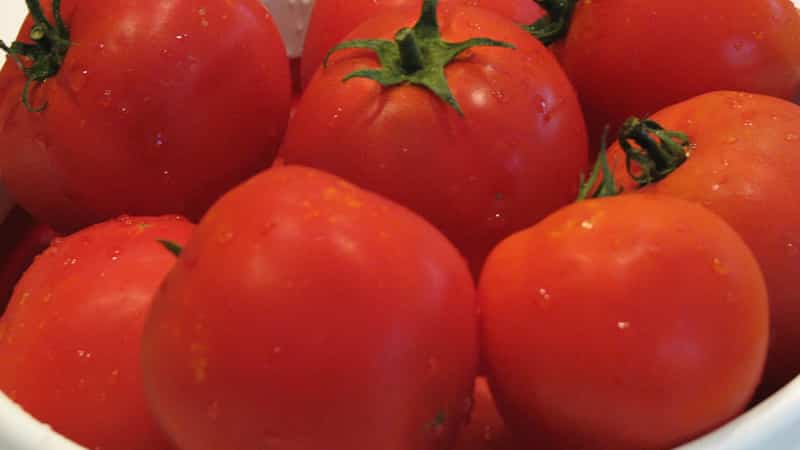 It is distinguished by stable immunity to dangerous diseases of the nightshade family, immune to late blight and brown spot.
It is distinguished by stable immunity to dangerous diseases of the nightshade family, immune to late blight and brown spot.
The culture requires, despite its short stature, obligatory garter, otherwise the fruit-bearing branches will break from the weight of the fruit. To increase productivity, the plant is formed into 1-2 stems, removing all excess shoots.
The variety tolerates sharp drops in temperature and dry days.
Fruit characteristics
Average weight 90-100 g, round shape, bright red color. The pulp is dense, the taste is sweet with an admixture of pronounced sourness. The fruits are distinguished by a thick and durable peel, thanks to which they are used for drying, freezing, and various marinades and conservation. To prepare fresh dishes, the thick peel is removed, which improves the taste of vegetables, especially in summer salads.
Ripe vegetables are stored for a long time, do not crack and can withstand transportation over any distance.
The photo shows Kolkhozny harvest tomatoes.
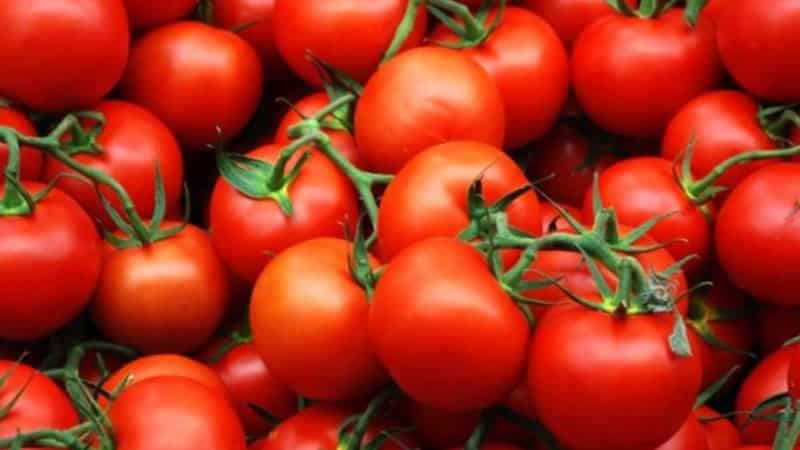
How to grow seedlings
Sowing seeds for seedlings begins 2 months before planting in the ground. Before sowing, it is necessary to prepare and disinfect the seed material.
Seed preparation
Seeds are determined for emptiness by immersing them in a saline solution for 10 minutes. Those that have floated to the surface are not suitable for landing. Then disinfection is carried out in a weak solution of potassium permanganate. Manganese can be replaced with a 2% hydrogen peroxide solution.
Reference! Disinfection prevents many diseases in the future.
To improve germination, grains are soaked in a growth stimulator for 10-11 hours. The most popular drugs are Epin and Kornevin. In the absence of specialized products, you can use aloe juice or potato juice.
The final procedure in preparing seeds is hardening. To do this, the grains are placed in the refrigerator on the bottom shelf at a temperature of +2°C for 12 hours. After this, the grains are heated for 14 hours at a temperature of +22°C. This procedure is carried out to increase productivity.
Reference! Hardening is a serious procedure, which is carried out by experienced gardeners, since with the wrong technology you can ruin all the seed.
Container and soil
The soil is prepared from garden soil mixed with river sand and peat in equal quantities. 200 g of wood ash is added to the resulting mixture to normalize the acidity. If the acidity in the soil is neutral, the ash will serve as an additional nutrient.
The prepared soil is disinfected, destroying pathogenic flora. To do this, the soil is spilled with a hot solution of dark potassium permanganate or calcined in the oven at a temperature of 60°C for 10 minutes.
The cooled soil is laid out in planting containers, making drainage holes at the bottom in advance to easily remove excess moisture. Also, pebbles or sawdust are placed on the bottom as drainage. The containers are filled halfway with soil, gradually adding soil as the seedlings grow. This way the seedlings receive the required amount of nutrients.
Plant in a common wooden box or in separate containers. Planting in separate containers eliminates in the future many necessary procedures that are carried out when propagating seedlings in a common container.
Sowing
Seeds are sown to a depth of 1 cm with a distance of 3-4 cm from each other. The furrows are covered with soil on top, leveled, slightly moistened with a spray bottle with warm, settled water and covered with film to create a greenhouse effect.
The containers are left in a warm and dark room at a temperature of at least 25°C until germination.
Seedling care
When the first shoots appear, the film is removed and the containers are moved to the windowsill. The seedlings are carefully watered with warm, settled water, along the edge of the seedling with a tablespoon. There is no need to flood the soil; oversaturation with moisture will negatively affect the developing roots.
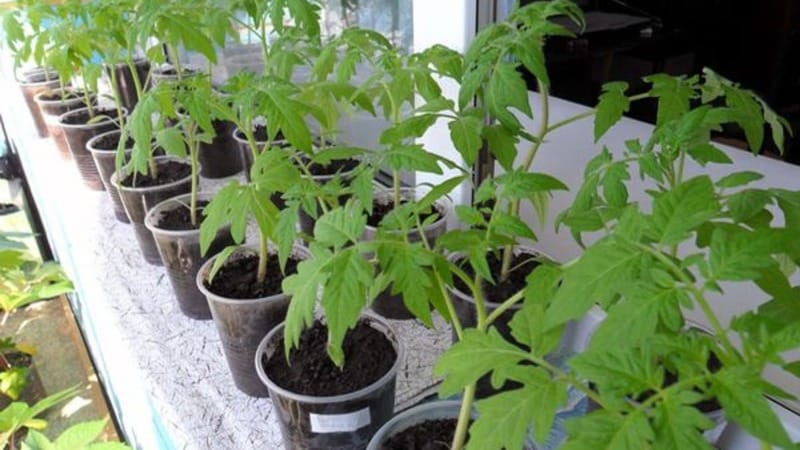 After the appearance of two true leaves, the seedlings dive and are planted in a separate container. If the seeds are sown in peat cups, picking is not required. The picking procedure involves removing the main root by one third. After picking, young plants intensively grow lateral roots, which helps strengthen the stem.
After the appearance of two true leaves, the seedlings dive and are planted in a separate container. If the seeds are sown in peat cups, picking is not required. The picking procedure involves removing the main root by one third. After picking, young plants intensively grow lateral roots, which helps strengthen the stem.
Reference! During picking, stronger seedlings are left for further growth and development, and weak ones are disposed of.
After planting, the first fertilizing is carried out. Organic matter is used as fertilizer, for example, mullein infusion or chicken manure in a ratio of 1:15. Seedlings respond well to fertilization and grow vigorously. The second feeding is applied two weeks after the first.
During the seedling period, it is necessary to feed the crop twice. The plant is not standard, the stem is weak, so adding additional nutrition is important to strengthen the bushes.
1 week before transplanting, the seedlings are hardened off by taking the planting containers out into the open air for 2 hours. Gradually, the stay on the street is increased to 15 hours. At the same time, the night temperature in the room is reduced to 12°C.
How to grow tomatoes
After 2 months, the seedlings are transplanted into the ground. By this time, the bushes have 5-7 true leaves and fully formed young roots.
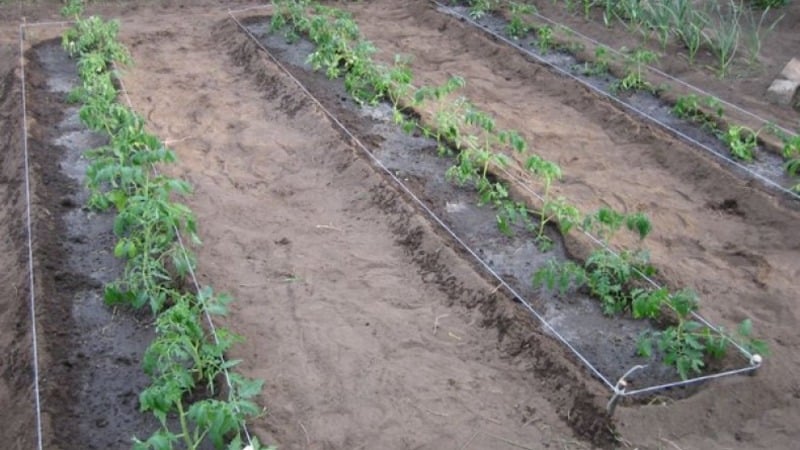
Landing
Choose a place for the beds that is sunny and protected from drafts. The holes are made in advance, no deeper than 20 cm, at the bottom of which a little mineral fertilizer is placed. Replant in the evening or on a cloudy day, so the young bushes will quickly get used to the new conditions.
Planting pattern: 40 cm – distance between seedlings, 70 cm – row spacing. For 1 sq. m place no more than 6 plants.
After transplanting, the holes are watered generously with warm, settled water and the seedlings are left to adapt to street conditions for 8-10 days.
Further care of the Kolkhozny fruitful variety
Regular watering Perform no more than 2 times a week, increasing the frequency only on dry days. Until the seedlings take root completely, it is important to ensure that the soil does not dry out. Water with warm, settled water, strictly at the root, without getting on the leaves in the morning or evening.
After watering, the soil is loosened and all weeds and roots are removed. Weeds are a breeding ground for infections; pathogenic spores and many pests successfully reproduce in them, so they must be removed from the beds without fail.
To retain moisture in the beds mulch peat or straw. Mulching also performs a preventive function, preventing insect pests from reaching the root system.
Fertilizing is applied three times per season. As fertilizers, a full complex of mineral fertilizers or organic matter is used. From organic matter, mullein infusion or bird droppings are used in a ratio of 1:15.
The first time is fed during the budding period, the second time is applied during the formation of the ovaries, and the third time is fed during the fruiting period. At this time, potassium salts are added to accelerate the ripening of fruits.
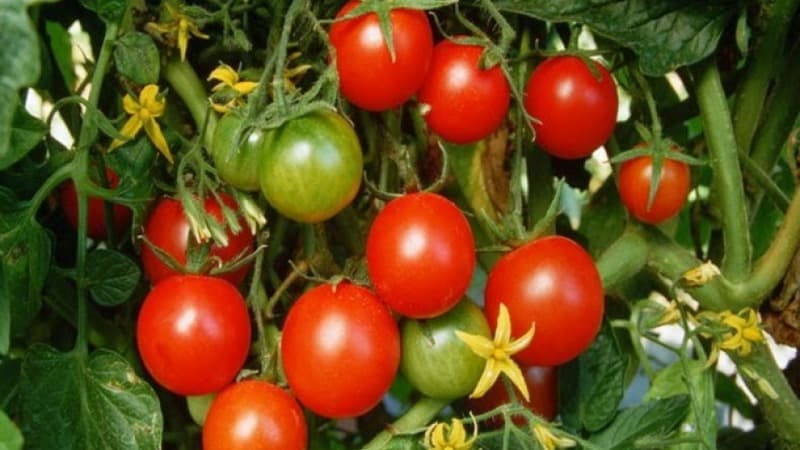
Features of cultivation and possible difficulties
Despite its small growth, the crop is tied to wooden or metal supports installed next to the bushes during transplantation. An unfixed, fragile stem will not be able to withstand the weight of fruitful branches. It is fixed almost immediately after transplanting the seedlings into the ground. As the branches grow and develop, they are also tied to a support so that as the vegetables ripen, their integrity is not compromised.
In addition to vertical support, horizontal trellises are often installed in the garden. To do this, metal supports are mounted on different sides of the bed and a wire is pulled between them, to which the stem and branches are fixed with soft fabric tapes.
For the greatest quantitative indicator, the culture is formed into 1 or 2 trunks. To do this, remove all excess shoots, leaving them only under the first and above the second flower brush. The lower leaves are also removed so that they do not come into contact with wet beds and do not serve as an obstacle to receiving the required amount of light.
Diseases and pests
The culture is distinguished by its stable immunity to many diseases, in particular late blight. Nevertheless, experienced vegetable growers do not forget about preventive measures, thereby further strengthening the plant’s immunity.
Prevention includes:
- moderate watering;
- systematic loosening;
- weed removal;
- ventilation of closed structures (if the crop is planted in a greenhouse);
- treating the land with copper sulfate.
These same preventive measures protect against pests that are dangerous to tomato bushes. But often prevention alone is not enough and pests still appear in the beds.
The drug “Prestige” will help in the fight against the Colorado potato beetle, which is used to spray entire plants.
Important! If potatoes are planted next to tomatoes, they are processed first. Often it is potatoes that act as carriers of diseases and pests.
Planting sharp-smelling herbs next to the bushes will protect them from many insects, since most of them do not like strong odors. Additionally, pheromone traps are installed for the whitefly butterfly. They attract pests, but are completely safe for other insects.
The nuances of breeding in open ground and in a greenhouse
The variety is interesting because it can be grown in seedlings and without seedlings. In the second case, fruiting will occur a little later, but nevertheless, the seedless method is a big plus for the southern regions. Many gardeners sow seeds directly into open ground or under film, which does not in any way affect the quality and quantity of fruits.
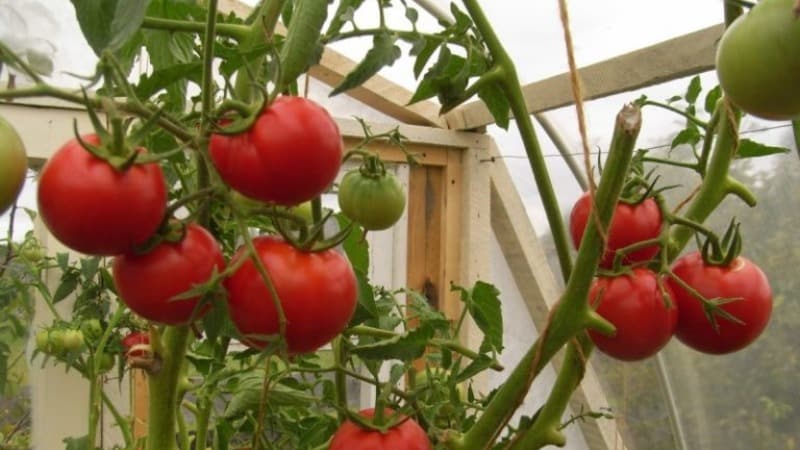 Greenhouse plants exceed the growth stated by the manufacturer and sometimes reach 1 m. To prevent plants from wasting nutrients on the growth of unnecessary branches, the crown is pinched, thereby determining the growth point.
Greenhouse plants exceed the growth stated by the manufacturer and sometimes reach 1 m. To prevent plants from wasting nutrients on the growth of unnecessary branches, the crown is pinched, thereby determining the growth point.
Closed structures are ventilated daily. An influx of fresh air is necessary for the full development of seedlings, and it also destroys the usual habitat of some pests.
Harvesting and application
Early fruiting lasts up to 3 weeks. The fruits ripen almost simultaneously, which makes harvesting much easier. To avoid overloading the bush, ripe vegetables are removed regularly.
The purpose of the fruits is universal: they are used fresh and for winter preparations.To prepare summer salads, vegetable stews and first courses, remove the thick skin from the tomatoes.
But for whole-fruit canning, such a strong peel is an advantage: the tomatoes do not crack during heat treatment, perfectly retaining their taste. They are also excellent for processing into tomato products: they make excellent juices, pastes, adjika, ketchup, where the tomatoes retain their unusual acidity.
Ripe vegetables can be stored for a long time at a temperature of 10-15°C. Vegetables also tolerate transportation well over any distance.
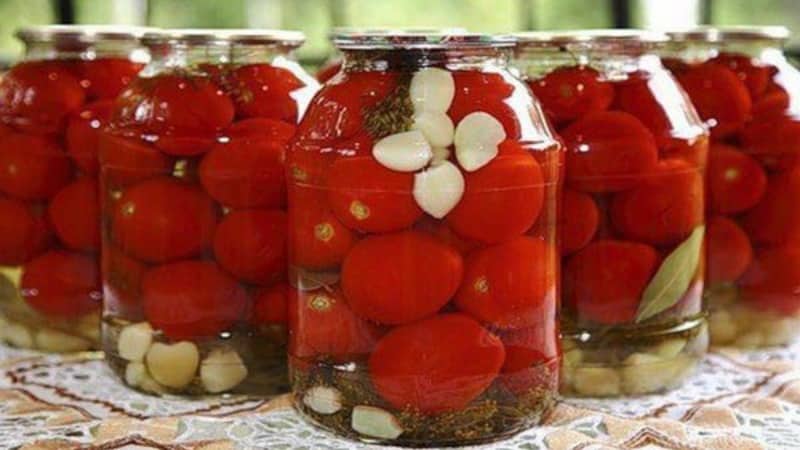
Advantages and disadvantages of the variety
The variety has many positive aspects:
- adaptation to any weather conditions;
- cold resistance;
- ease of care;
- small and compact stature;
- stable immunity to diseases;
- high-yielding species;
- the possibility of propagation using the seedless method;
- excellent taste of fruits;
- simultaneous maturation;
- versatility in cooking;
- long-term storage;
- long transportations.
The disadvantages include the obligatory garter and the formation of bushes. But for experienced gardeners, these procedures are familiar agricultural techniques that do not cause difficulties.
Farmer reviews
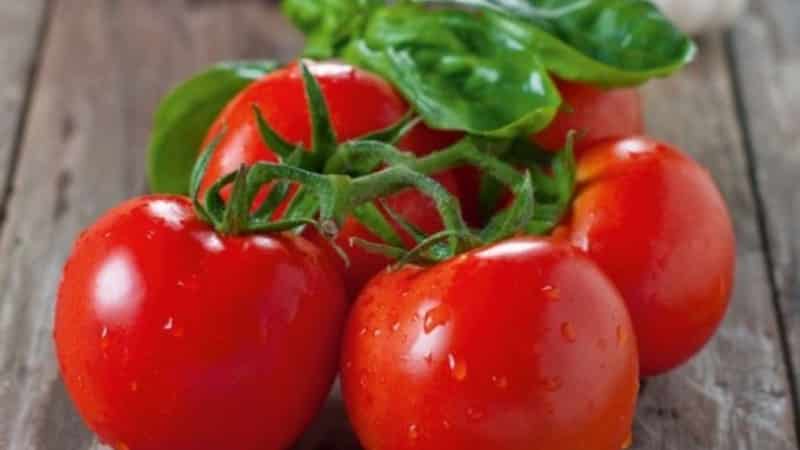
Many positive reviews indicate the reliability of the crop and its unpretentiousness over the entire growing season. Here are some opinions of those who planted tomatoes on their plots:
Valentina, Saratov region: “I first saw the variety in a photograph. I really liked the small compact bushes. I decided to plant it in my garden. The fruits were ready for harvest 100–115 days from the date of planting. The tomatoes are all smooth, with sweet pulp, and medium in size. Suitable for twists and fresh consumption.I didn’t find any cons for myself. I recommend it to everyone!”
Margarita, Moscow: “I spent a long time choosing a species that is suitable for open ground. I heard good reviews about Kolkhozny and decided to imprison him. The name was justified; given the cool summer, we managed to get a decent harvest. The plant is not fussy to care for; a novice gardener can handle it.”
Conclusion
The advantages of the Kolkhoz harvest tomato are time-tested; it is known in all regions of the country as high-yielding, reliable, resistant to many diseases and easy to care for. It is these characteristics that the tomato has earned the love of many gardeners and popularity among tomato crops.
For the older generation, this tomato is a kind of reminder of the times of the Soviet Union. This tomato crop was developed at that time for industrial cultivation in collective farming.